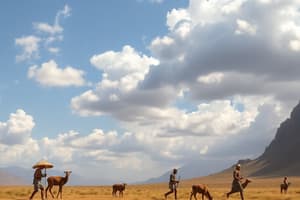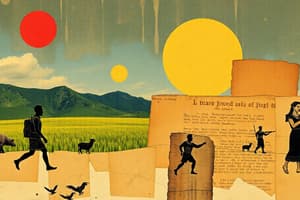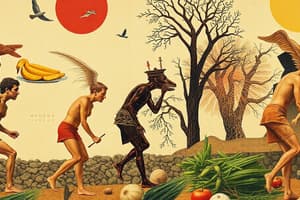Podcast
Questions and Answers
What is the Neolithic Revolution?
What is the Neolithic Revolution?
A major turning point in human history when humans began to cultivate crops and domesticate animals around 10,000 BCE.
Why did people change from hunter-gatherers to farmers?
Why did people change from hunter-gatherers to farmers?
Because temperatures increased after the Ice Age ended, resulting in a mild climate and fertile land for growing crops.
How did the people of the Agricultural Revolution grow crops?
How did the people of the Agricultural Revolution grow crops?
They used seeds that they collected from grains gathered by hunter-gatherers.
How did farming change people's lives?
How did farming change people's lives?
How did farming affect the growth of population?
How did farming affect the growth of population?
What was life like in the Neolithic Age?
What was life like in the Neolithic Age?
What were the benefits of a settled life?
What were the benefits of a settled life?
What were the roles of men in the Neolithic period?
What were the roles of men in the Neolithic period?
What were the roles of women in the Neolithic period?
What were the roles of women in the Neolithic period?
What is systematic agriculture?
What is systematic agriculture?
What does specialization mean?
What does specialization mean?
How is the agricultural revolution really a revolution?
How is the agricultural revolution really a revolution?
How did the domestication of animals change the lives of humans during the Neolithic period?
How did the domestication of animals change the lives of humans during the Neolithic period?
What was the first animal to be domesticated?
What was the first animal to be domesticated?
What were the second animals to be domesticated, and why were these animals important?
What were the second animals to be domesticated, and why were these animals important?
How did they domesticate the animals?
How did they domesticate the animals?
Where did most of the early villages spring up?
Where did most of the early villages spring up?
Why did the Mesopotamians live near the Tigris and Euphrates and the Egyptians near the Nile?
Why did the Mesopotamians live near the Tigris and Euphrates and the Egyptians near the Nile?
Flashcards are hidden until you start studying
Study Notes
Neolithic Revolution
- Major turning point around 10,000 BCE characterized by the cultivation of crops and domestication of animals.
- Transition from nomadic hunter-gatherer lifestyle to permanent settlements.
Shift to Farming
- Climatic changes post-Ice Age led to milder conditions and fertile land.
- Increased temperatures facilitated the development of agriculture.
Agricultural Practices
- Use of seeds collected from grains by hunter-gatherers laid the foundation for crop growth.
Impact of Farming on Society
- Shift to a settled existence resulted in permanent homes and the establishment of early governance.
- Enabled the domestication of animals, advent of written language, technological advancements, labor specialization, and trade.
Population Growth
- Consistent food supply from agriculture led to population increases.
Life in the Neolithic Age
- Formation of villages with permanent residences located near fertile fields and water sources.
- Proximity to rivers essential for survival and agricultural practices.
Advantages of Settled Life
- Improved safety from natural elements and wildlife.
- Enhanced security and health due to stable food supplies.
- Surpluses allowed for trade and reduced reliance on farming alone, leading to job specialization.
Roles in Society
- Men engaged in farming and herding, emerging as leaders within families and communities.
- Women focused on household management, weaving, and child-rearing.
Systematic Agriculture
- Defined as the organized, regular growing of crops and raising of domesticated animals.
Specialization
- Individuals began transitioning to specialized jobs based on skills beyond farming.
Significance of the Agricultural Revolution
- Represented a profound change in human lifestyles, moving away from hunter-gatherer ways.
Domestication of Animals
- Enabled access to resources like wool, meat, and milk, while providing transport and labor through strong animals like cows.
Early Domesticated Animals
- Sheep and goats were the first to be domesticated, followed by cows and pigs, which provided both meat and milk and contributed to agricultural productivity.
Domestication Methods
- Animals were secured in fenced areas (pens) to facilitate domestication.
Location of Villages
- Early civilizations developed near water sources, vital for agriculture and daily survival.
Importance of Rivers
- Mesopotamians relied on the Tigris and Euphrates rivers, while Egyptians depended on the Nile for irrigation and fertile soil necessary for crop growth.
Studying That Suits You
Use AI to generate personalized quizzes and flashcards to suit your learning preferences.





